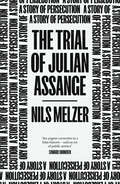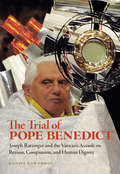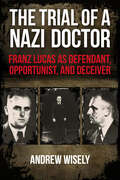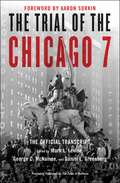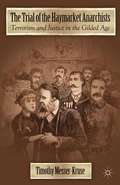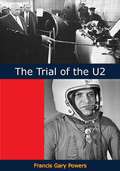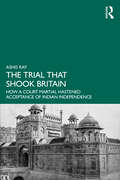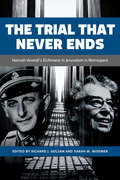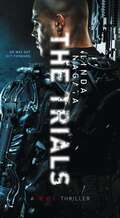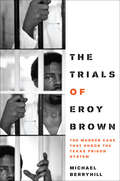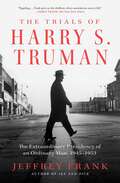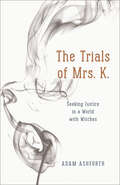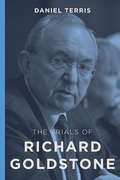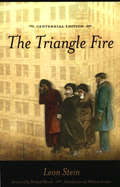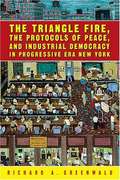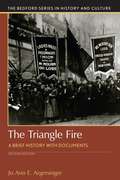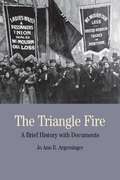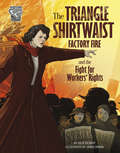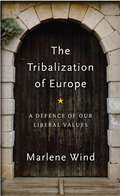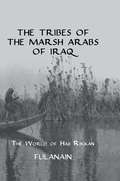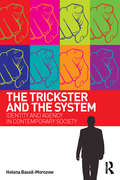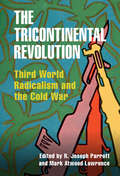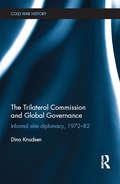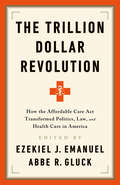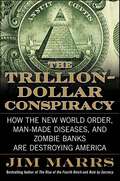- Table View
- List View
The Trial of Julian Assange: A Story of Persecution
by Nils MelzerThe shocking story of the legal persecution of Wikileaks founder Julian Assange and the dangerous implications for the whistleblowers of the future.In July 2010, Wikileaks published Cablegate, one of the biggest leaks in the history of the US military, including evidence for war crimes and torture. In the aftermath Julian Assange, the founder and spokesman of Wikileaks, found himself at the center of a media storm, accused of hacking and later sexual assault. He spent the next seven years in asylum in the Ecuadorian embassy in London, fearful that he would be extradited to Sweden to face the accusations of assault and then sent to US. In 2019, Assange was handed over to the British police and, on the same day, the U.S. demanded his extradition. They threatened him with up to 175 years in prison for alleged espionage and computer fraud.At this point, Nils Melzer, UN Special Rapporteur on Torture, started his investigation into how the US and UK governments were working together to ensure a conviction. His findings are explosive, revealing that Assange has faced grave and systematic due process violations, judicial bias, collusion and manipulated evidence. He has been the victim of constant surveillance, defamation and threats. Melzer also gathered together consolidated medical evidence that proves that Assange has suffered prolonged psychological torture.Melzer&’s compelling investigation puts the UK and US state into the dock, showing how, through secrecy, impunity and, crucially, public indifference, unchecked power reveals a deeply undemocratic system. Furthermore, the Assange case sets a dangerous precedent: once telling the truth becomes a crime, censorship and tyranny will inevitably follow. The Trial of Julian Assange is told in three parts: the first explores Nils Melzer&’s own story about how he became involved in the case and why Assange&’s case falls under his mandate as the Special Rapporteur on Torture. The second section returns to 2010 when Wikileaks released the largest leak in the history of the U.S. military, exposing war crimes and corruption, and Nils makes the case that Swedish authorities manipulated charges against Assange to force his extradition to the US and publicly discredit him. In the third section, the author returns to 2019 and picks up the case as Ecuador kicks Assange out of the embassy and lays out the case as it currently stands, as well as the stakes involved for other potential whistleblowers trying to serve the public interest.
The Trial of Pope Benedict
by Daniel GawthropIn this persuasive new book, Daniel Gawthrop examines how Joseph Ratzinger (Pope Benedict XVI) systematically steered the Catholic Church to the far right, and what his shocking resignation means for the Church as it navigates a new world. By doing so, it reveals one of recent history's most astonishing tales of institutional power, religious bullying, and systemic abuse.
The Trial of a Nazi Doctor: Franz Lucas as Defendant, Opportunist, and Deceiver
by Andrew WiselyThe Trial of a Nazi Doctor examines the life of Franz Bernhard Lucas (1911-1994), an SS camp doctor with assignments in Auschwitz, Mauthausen, Stutthof, Ravensbrück, and Sachsenhausen. Covering his career during the Third Reich and then his prosecution after 1945, especially in the Frankfurt Auschwitz trial, Andrew Wisely explores the lies, obfuscations, misrepresentation, and confusions that Lucas himself created to deny, distract from or excuse his participation in the Nazi’s genocidal projects. By juxtaposing Lucas’s own testimonies and those of a wide range of witnesses: former camp inmates and Holocaust survivors; friends, colleagues, and relatives; and media observers, Wisely provides a nuanced study of witness testimonies and the moral identity of Holocaust perpetrators.
The Trial of the Chicago 7: The Official Transcript
by Daniel Greenberg Mark L. Levine George McNameeRepublished fifty years later to coincide with the release this fall of the film of the same title written and directed by Aaron Sorkin with an all-star cast, this is the classic account of perhaps the most infamous, and definitely the most entertaining, trial in recent American history.In the fall of 1969 eight prominent anti-Vietnam War activists were put on trial for conspiring to riot at the 1968 Democratic National Convention in Chicago. One of the eight, Black Panther cofounder Bobby Seale, was literally bound and gagged in court by order of the judge, Julius Hoffman, and his case was separated from that of the others. The activists, who included Abbie Hoffman, Jerry Rubin, and Tom Hayden, and their attorneys, William Kunstler and Leonard Weinglass, insisted that the First Amendment was on trial. Their witnesses were a virtual who&’s who of the 1960s counterculture: Allen Ginsberg, Timothy Leary, Arlo Guthrie, Judy Collins, Norman Mailer, among them. The defendants constantly interrupted to protest what they felt were unfair rulings by the judge. The trial became a circus, all the while receiving intense media coverage. The convictions that resulted were subsequently overturned on appeal, but the trial remained a political and cultural touchstone, a mirror of the deep divisions in the country. The Trial of the Chicago 7 consists of the highlights from trial testimony with a brief epilogue describing what later happened to the principal figures.
The Trial of the Haymarket Anarchists
by Timothy Messer-KruseThe Trial of the Haymarket Anarchists is the culmination of seven years of research into the 1886 Haymarket bombing and subsequent trial. It not only overturns the prevailing consensus on this event, it documents in detail how the basic facts, as far as they can be determined, have been distorted, obscured, or suppressed for seventy years.
The Trial of the U2: Exclusive Authorized Account of the Court Proceedings of the Case of Francis Gary Powers
by Harold J. Berman Francis Gary PowersFirst published in 1960, this is the only authorized account of the trial of Francis Gary Powers, the U-2 pilot shot down by the Soviet Union on May 1, 1960. The court proceedings were held before the Military Division of the Supreme Court of the U.S.S.R. in Moscow, Russia and commenced on August 17, 1960 and concluded on August 19, 1960.Includes introductory comments written by internationally renowned authority on Soviet law, Professor Harold J. Berman, and richly illustrated throughout with exclusive courtroom photos.An exclusive ringside seat at one of the most dramatic trials in modern times!
The Trial that Shook Britain: How a Court Martial Hastened Acceptance of Indian Independence
by Ashis RayThe Indian National Army (INA) trials of 1945–46 have generally been given short shrift by historians in their cataloguing of the Indian freedom movement. This book examines to what extent the trials had an impact on the final phase of India’s quest for independence. In so doing, it unveils that, while the Indian National Congress’s extended odyssey to win independence was essentially about a passive push-back, at a critical juncture of its campaign to extinguish British colonialism in India, it applauded and capitalised on the INA’s use of force. The central, explosive narrative is about Britain holding a court martial of three officers of the INA – Shah Nawaz Khan, Prem Sahgal and Gurbaksh Dhillon – convicting them, before a dramatic turn in events.The material unearthed by the book throws new light on a decisive juncture leading to the transfer of power in India. It will be indispensable for researchers interested in South Asia, especially the Indian freedom movement. It will be invaluable for students of history, colonialism, military studies, politics in pre-Partition India and law.
The TrialThat Never Ends: Hannah Arendt's 'Eichmann in Jerusalelm' in Retrospect
by Richard J. Golsan Sarah MisemerThe fiftieth anniversary of the Adolf Eichmann trial may have come and gone but in many countries around the world there is a renewed focus on the trial, Eichmann himself, and the nature of his crimes. This increased attention also stimulates scrutiny of Hannah Arendt’s influential and controversial work, Eichmann in Jerusalem. The contributors gathered together by Richard J. Golsan and Sarah M. Misemer in The Trial That Never Ends assess the contested legacy of Hannah Arendt’s famous book and the issues she raised: the "banality of evil", the possibility of justice in the aftermath of monstrous crimes, the right of Israel to kidnap and judge Eichmann, and the agency and role of victims. The contributors also interrogate Arendt’s own ambivalent attitudes towards race and critically interpret the nature of the crimes Eichmann committed in light of newly discovered Nazi documents. The Trial That Never Ends responds to new scholarship by Deborah Lipstadt, Bettina Stangneth, and Shoshana Felman and offers rich new ground for historical, legal, philosophical, and psychological speculation.
The Trials (The Red Trilogy #2)
by Linda NagataIn the wake of nuclear terrorism, a squad of elite soldiers must combat artificial intelligence and seek justice in this military political thriller, a sequel to The Red.Lieutenant James Shelley and his squad of US Army soldiers were on a quest for justice when they carried out the unauthorized mission known as First Light. They returned home to America to face a court-martial, determined to expose the corruption in the chain of command that compelled their actions. But in a country still reeling from the nuclear terrorism of Coma Day, the courtroom is just one battlefield of many.A new cycle of violence ignites when rumors of the elusive, rogue AI known as the Red go public—and Shelley is, once again, pulled into the fray. Challenged by his enemies, driven by ideals, Shelley feels compelled to act. But are the harrowing choices he makes really his own, or are they made for him, by the Red? And with millions of lives at stake in a game of nuclear cat-and-mouse, does the answer even matter?
The Trials of Eroy Brown: The Murder Case That Shook the Texas Prison System (Jack and Doris Smothers Series in Texas History, Life, and Culture)
by Michael Berryhill&“Berryhill&’s account of this infamous 30-year-old murder case . . . Provides a jarring portrait of a once-medieval state prison.&” —Publishers Weekly In April 1981, two white Texas prison officials died at the hands of a black inmate at the Ellis prison farm near Huntsville. Warden Wallace Pack and farm manager Billy Moore were the highest-ranking Texas prison officials ever to die in the line of duty. The warden was drowned face down in a ditch. The farm manager was shot once in the head with the warden&’s gun. The man who admitted to killing them, a burglar and robber named Eroy Brown, surrendered meekly, claiming self-defense. In any other era of Texas prison history, Brown&’s fate would have seemed certain: execution. But in 1980, federal judge William Wayne Justice had issued a sweeping civil rights ruling in which he found that prison officials had systematically and often brutally violated the rights of Texas inmates. In the light of that landmark prison civil rights case, Ruiz v. Estelle, Brown had a chance of being believed. The Trials of Eroy Brown, the first book devoted to Brown&’s astonishing defense, is based on trial documents, exhibits, and journalistic accounts of Brown&’s three trials, which ended in his acquittal. Michael Berryhill presents Brown&’s story in his own words, set against the backdrop of the chilling plantation mentality of Texas prisons. Brown&’s attorneys—Craig Washington, Bill Habern, and Tim Sloan—undertook heroic strategies to defend him, even when the state refused to pay their fees. The Trials of Eroy Brown tells a landmark story of prison civil rights and the collapse of Jim Crow justice in Texas.
The Trials of Harry S. Truman: The Extraordinary Presidency of an Ordinary Man, 1945-1953
by Jeffrey FrankJeffrey Frank, author of the bestselling Ike and Dick, returns with the first full account of the Truman presidency in nearly thirty years, recounting how so ordinary a man met the extraordinary challenge of leading America through the pivotal years of the mid-20th century.The nearly eight years of Harry Truman&’s presidency—among the most turbulent in American history—were marked by victory in the wars against Germany and Japan; the first use of an atomic weapon; the beginning of the Cold War; creation of the NATO alliance; the founding of the United Nations; the Marshall Plan to rebuild the wreckage of postwar Europe; the Red Scare; and the fateful decision to commit troops to fight in Korea. Historians have tended to portray Truman as stolid and decisive, with a homespun manner, but the man who emerges in The Trials of Harry S. Truman is complex and surprising. He believed that the point of public service was to improve the lives of one&’s fellow citizens, and was disturbed by the brutal treatment of African Americans. Yet while he supported stronger civil rights laws, he never quite relinquished the deep-rooted outlook of someone with Confederate ancestry reared in rural Missouri. He was often carried along by the rush of events and guided by men who succeeded in refining his fixed and facile view of the postwar world. And while he prided himself on his Midwestern rationality, he could act out of emotion, as when, in the aftermath of World War II, moved by the plight of refugees, he pushed to recognize the new state of Israel. The Truman who emerges in these pages is a man with generous impulses, loyal to friends and family, and blessed with keen political instincts, but insecure, quick to anger, and prone to hasty decisions. Archival discoveries, and research that led from Missouri to Washington, Berlin and Korea, have contributed to an indelible, and deeply human, portrait of an ordinary man suddenly forced to shoulder extraordinary responsibilities, who never lost a schoolboy&’s romantic love for his country, and its Constitution.
The Trials of Mrs. K.: Seeking Justice in a World with Witches
by Adam AshforthIn March 2009, in a small town in Malawi, a nurse at the local hospital was accused of teaching witchcraft to children. Amid swirling rumors, “Mrs. K.” tried to defend her reputation, but the community nevertheless grew increasingly hostile. The legal, social, and psychological trials that she endured in the struggle to clear her name left her life in shambles, and she died a few years later. In The Trials of Mrs. K., Adam Ashforth studies this and similar stories of witchcraft that continue to circulate in Malawi. At the heart of the book is Ashforth’s desire to understand how claims to truth, the pursuit of justice, and demands for security work in contemporary Africa, where stories of witchcraft can be terrifying. Guiding us through the history of legal customs and their interactions with the court of public opinion, Ashforth asks challenging questions about responsibility, occult forces, and the imperfect but vital mechanisms of law. A beautifully written and provocative book, The Trials of Mrs. K. will be an essential text for understanding what justice means in a fragile and dangerous world.
The Trials of Richard Goldstone
by Daniel TerrisIn June 2009, Richard Goldstone was a global hero, honored by the MacArthur Foundation for its prize in international justice. Four months later, he was called a “quisling” and compared to some of the worst traitors in human history. Why? Because this champion of human rights and international law chose to apply his commitments to fairness and truth to his own community. The Trials of Richard Goldstone tells the story of this extraordinary individual and the price he paid for his convictions. It describes how Goldstone, working as a judge in apartheid South Africa, helped to undermine this unjust system and later, at Nelson Mandela’s request, led a commission that investigated cases of racial violence and intimidation. It also considers the international renown he received as the chief United Nations prosecutor for war crimes committed in Rwanda and the former Yugoslavia, the first tribunals to try political and military leaders on charges of genocide. Finally, it explores how Goldstone became a controversial figure in the wake of the Jewish jurist’s powerful, but flawed, investigation of Israel for alleged war crimes in Gaza. Richard Goldstone’s dramatic life story reveals that even in a world rife with prejudice, nationalism, and contempt for human rights, one courageous man can advance the cause of justice.
The Triangle Fire
by Leon SteinOn March 25, 1911, 146 employees of the Triangle Shirtwaist Company in New York City were killed in the span of a few minutes because no provision had been made for their safety in the event of fire. The Cornell edition of Leon Stein's 1962 account features 16 illustrations, some never before published. A new introduction by the journalist William Greider makes clear that accounts of dangerous workplaces and sweatshop conditions are still all-too-relevant today, ninety years after the fire. The story of the catastrophe and the doomed Triangle Shirtwaist workers, as told by one of the great labor journalists, will not soon be forgotten. Praise for the 1962 edition- "Stein . . . recreate[s] the tragic events of the fire in all their dramatic intensity. His moving account is a work of dedication. "-New York Times Book Review "With commendable restraint, [Stein] uses newspapers, official documents, and the evidence of survivors to unfold a story made more harrowing by the unemotional simplicity of its narration. "-Library Journal "Stein . . . suggests that the fire alerted the public to shocking working conditions all over the city and helped the unions organize the clothing industry, but his good taste keeps him from selling the reader any silver lining. A by-product of the careful research that has gone into this excellent narrative is an interesting sketch of the hard lives and times of working girls in the days when the business of America was business. "-New Yorker
The Triangle Fire, the Protocols of Peace, and Industrial Democracy in Progressive Era New York
by Richard GreenwaldAmerica searched for an answer to "The Labor Question" during the Progressive Era in an effort to avoid the unrest and violence that flared so often in the late 19th and early 20th century. In the ladies' garment industry, a unique experiment in industrial democracy brought together labor, management, and the public. As Richard Greenwald explains, it was an attempt to "square free market capitalism with ideals of democracy to provide a fair and just workplace." Led by Louis Brandeis, this group negotiated the "Protocols of Peace." But in the midst of this experiment, 146 mostly young, immigrant women died in the Triangle Factory Fire of 1911. As a result of the fire, a second, interrelated experiment, New York's Factory Investigating Commission (FIC) - led by Robert Wagner and Al Smith - created one of the largest reform successes of the period. The Triangle Fire, the Protocols of Peace, and Industrial Democracy in Progressive Era New York uses these linked episodes to show the increasing interdependence of labor, industry, and the state. Greenwald explains how the Protocols and the FIC best illustrate the transformation of industrial democracy and the struggle for political and economic justice.
The Triangle Fire: A Brief History with Documents
by Jo Ann E. ArgersingerThis book documents the historical Triangle factory fire of 1911 in New York which took the lives of 146 workers--most of them young immigrant women-- and became a powerful symbol of the peril industrial workers faced. Chronology, questions for consideration, a selected bibliography, and an index will enrich students' understanding of this historical moment.
The Triangle Shirtwaist Factory Fire and the Fight for Workers' Rights (Movements and Resistance)
by Julie GilbertIn November 1909, thousands of factory workers walked off the job to protest the terrible working conditions in New York City factories. Joining the picket lines was dangerous, with thugs and police officers harassing picketers, but the protests stirred action. Many factory owners finally agreed to some of the workers’ demands and improved conditions. But nothing changed for workers at the Triangle Shirtwaist Factory, and those workers would pay a high price for the company's dangerous conditions. In 1911, a devastating fire swept through the Triangle factory, killing 146 workers. In the months following the tragedy, the rights of workers finally gained real traction as the state government formed a safety commission and enacted new safety laws.
The Tribalization of Europe: A Defence of our Liberal Values
by Marlene WindTribalization is a global megatrend in today’s world. The election of Donald Trump, the Brexit vote, populist movements like Catalan separatism – together with democratic backsliding in Central and Eastern Europe – are all examples of tribalization. Fuelled by anti-globalism and identity politics, tribalization is drawing up the drawbridge to the world. It is putting cultural differences before dialogue, collaboration and universal liberal values. But tribalism is a dangerous road to go down. With it, argues Marlene Wind, we have put democracy itself in danger. Tribalism is not just about being pro-nation, anti-EU and anti-global. It is in many instances a bigger and more fundamental movement that casts aside the liberal democratic principles we once held in common. At a time when former defenders of liberal values are increasingly silent or have even joined the growing chorus of tribalists, this book is a wakeup call. Drawing on a wide range of examples from the UK and the US to Spain, Hungary and Poland, Wind highlights the dangers of identity politics and calls on people to stand up for democracy and the rule of law.
The Tribes Of The Marsh Arabs of Iraq: The World of Haji Rikkan
by FulanainThe Arab tribes of Iraq differ widely in custom but remain in all essentials of thought and conduct a distinctive and unique group. Their land embraces wide deserts, fertile fields and boundless swamps; its unique features shape the lives of its people. Taking the figure of Haji Rikkan as a central focus, the writer-traveller attempts to create a picture of Arab tribal life as a whole.
The Trickster and the System: Identity and agency in contemporary society
by Helena Bassil-MorozowFor centuries, the trickster has been used in various narratives, including mythological, literary and cinematic, to convey the idea of agency, rebellion and, often turbulent, progress. In The Trickster and the System: Identity and Agency in Contemporary Society, Helena Bassil-Morozow shows how the trickster can be seen as a metaphor to describe the psycho-anthropological concept of change, an impulse that challenges the existing order of things, a progressive force that is a-structural and anti-structural in its nature. The book is about being able to see things from an unusual, even ‘odd’, perspective, which does not coincide with the homogenous normality of the mass, or the social system, or a political ideology, or some other kind of authority. The Trickster and the System offers an analytical paradigm which can be used to examine relationships between tricksters and systems, change and stability, in a wide range of social, political and cultural contexts. It covers a range of systems, describes different types of tricksters and discusses possible conflicts, tensions and dialogues between the two opposing sides. One of the central ideas of the book is that social systems use shame as a tool to control and manage all kinds of tricksters – individuality, agency, creativity, spontaneity, innovation and initiative, to name but a few. The author argues that any society that neglects its tricksters (agents of change), ends up suffering from decay, stagnation – or even mass hysterical outbursts. The Trickster and the System: Identity and Agency in Contemporary Society provides a fresh perspective on the trickster figure in a variety of cultural contexts. It covers a range of psychological, cultural, social and political phenomena, from personal issues to the highest level of society’s functioning: self-esteem and shame, lifestyle and relationships, creativity and self-expression, media, advertising, economy, political ideology and, most importantly, human identity and authenticity. The book is essential reading for scholars in the areas of psychoanalysis, analytical psychology, myth, cultural and media studies, narrative analysis, cultural anthropology, as well as anyone interested in critical issues in contemporary culture. Helena Bassil-Morozow is a cultural philosopher, film scholar and academic writer whose many publications include Tim Burton: The Monster and the Crowd (Routledge, 2010) and The Trickster in Contemporary Film (Routledge, 2011). Helena is currently working on another Routledge project, Jungian Film Studies: the Essential Guide (co-authored with Luke Hockley). Her principal academic affiliation is the University of Bedfordshire, Faculty of Creative Arts, Technologies & Science.
The Tricontinental Revolution: Third World Radicalism and the Cold War (Cambridge Studies in US Foreign Relations)
by Mark Atwood Lawrence R. Joseph ParrottThe Tricontinental Revolution provides a major reassessment of the global rise and impact of Tricontinentalism, the militant strand of Third World solidarity that defined the 1960s and 1970s as decades of rebellion. Cold War interventions highlighted the limits of decolonization, prompting a generation of global South radicals to adopt expansive visions of self-determination. Long associated with Cuba, this anti-imperial worldview stretched far beyond the Caribbean to unite international revolutions around programs of socialism, armed revolt, economic sovereignty, and confrontational diplomacy. Linking independent nations with non-state movements from North Vietnam through South Africa to New York City, Tricontinentalism encouraged marginalized groups to mount radical challenges to the United States and the inequitable Euro-centric international system. Through eleven expert essays, this volume recenters global political debates on the priorities and ideologies of the Global South, providing a new framework, chronology, and tentative vocabulary for understanding the evolution of anti-imperial and decolonial politics.
The Trilateral Commission and Global Governance: Informal Elite Diplomacy, 1972-82 (Cold War History)
by Dino KnudsenThis book provides the first analysis of the Trilateral Commission and its role in global governance and contemporary diplomacy. In 1973, David Rockefeller and Zbigniew Brzezinski founded the Trilateral Commission. Involving highly influential people from business and politics in the US, Western Europe, and Japan, the Commission was soon preceived as constituting an embryonic or even shadow world government. As the first researcher to have accessed the Commission’s archives, the author argues that this study demonstrates that global governance and international diplomacy should be considered a product of overlapping elite networks that merge informal and formal spheres across national borders. This work has three immediate aims: to trace the background, origins, purposes, characteristics, and modus operandi of the Commission; to investigate the elite aspect of the Commission and how this related to democracy; and to demonstrate how the Commission contributed to diplomatic practices and policy-formulation at national and international levels. The overall purpose of this book is to evaluate the significance of the Trilateral Commission, with particular focus on the implications of its activities on the way we understand decision-making processes and diplomacy in modern, democratic societies. This book will be of much interest to students of the Cold War, US foreign policy, diplomacy studies, and IR in general
The Trillion Dollar Revolution: How the Affordable Care Act Transformed Politics, Law, and Health Care in America
by Ezekiel J Emanuel Abbe R. GluckTen years after the landmark legislation, Ezekiel Emanuel leads a crowd of experts, policy-makers, doctors, and scholars as they evaluate the Affordable Care Act's history so far.In March 2010, the Affordable Care Act officially became one of the seminal laws determining American health care. From day one, the law was challenged in court, making it to the Supreme Court four separate times. It transformed the way a three-trillion-dollar sector of the economy behaved and brought insurance to millions of people. It spawned the Tea Party, further polarized American politics, and affected the electoral fortunes of both parties.Ten years after the bill's passage, a constellation of experts--insiders and academics for and against the ACA--describe the momentousness of the legislation. Encompassing Democrats and Republicans, along with legal, financial, and health policy experts, the essays here offer a fascinating and revealing insight into the political fight of a generation, its consequences for health care, politics, law, the economy-and the future.
The Trillion-Dollar Conspiracy: How the New World Order, Man-Made Diseases, and Zombie Banks Are Destroying America
by Jim Marrs“Jim Marrs can’t be ignored. Few in this country shout about The Truth louder than he.”—Dallas ObserverIn The Trillion-Dollar Conspiracy, Jim Marrs, the New York Times bestselling author of Rule by Secrecy and The Rise of The Fourth Reich, offers a terrifying proposition: that the current economic collapse has been engineered by a tyrannous government and multinational corporations determined to enslave us. Read The Trillion-Dollar Conspiracy and find out how the New World Order, man-made diseases, and zombie banks are destroying America.
